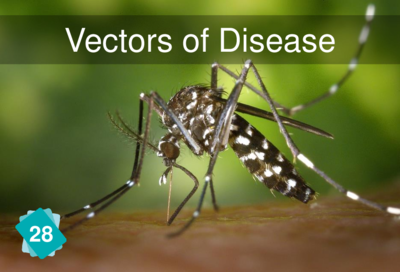En-en adult card 28 vectors of disease: Difference between revisions
Jump to navigation
Jump to search
No edit summary |
m (Minor corrections) |
||
| Line 4: | Line 4: | ||
|title=Vectors of Disease | |title=Vectors of Disease | ||
}} | }} | ||
== Explanation == | |||
The problem is not so much the proliferation of vectors of disease as their displacement. This card ideally comes after card 25, as vectors of disease are a sub-part of biodiversity. | |||
== Correction== | == Correction== | ||
| Line 10: | Line 13: | ||
=== Consequences === | === Consequences === | ||
*[[En-en_adult_card_38_human_health|Human Health]] | *[[En-en_adult_card_38_human_health|Human Health]] | ||
== Other possible links == | == Other possible links == | ||
=== Other causes === | === Other causes === | ||
[[En-en adult card 41 permafrost|Permafrost]]: Permafrost contains billions of buried bacteria and viruses. If it were to thaw, some of these pathogens could end up contaminating human or animal populations. In 2016, there was an anthrax epidemic in Siberia because of a 75-year-old carcass that was reported to have thawed<ref>[https://www.huffingtonpost.fr/2016/08/01/epidemie-anthrax-renes-siberie-fonte-permafrost_n_11292554.html Anthrax epidemic in Siberia kills 1500 reindeer as permafrost thaws (French)]</ref>. | * [[En-en adult card 20 disruption water cycle|Disruption of the water cycle]] and [[En-en adult card 21 temperature rise|temperature rise]]: The vectors of disease card is generally linked to the [[En-en adult card 25 terrestrial biodiversity|Terrestrial Biodiversity]] card because vectors of disease are a sub-part of biodiversity, but it can also be linked to the same causes as the biodiversity card, i.e. disruption of the water cycle and temperature rise. | ||
* [[En-en adult card 41 permafrost|Permafrost]]: Permafrost contains billions of buried bacteria and viruses. If it were to thaw, some of these pathogens could end up contaminating human or animal populations. In 2016, there was an anthrax epidemic in Siberia because of a 75-year-old carcass that was reported to have thawed<ref>[https://www.huffingtonpost.fr/2016/08/01/epidemie-anthrax-renes-siberie-fonte-permafrost_n_11292554.html Anthrax epidemic in Siberia kills 1500 reindeer as permafrost thaws (French)]</ref>. | |||
== References == | == References == | ||
Revision as of 16:08, 5 April 2021
Card #28: Vectors of Disease
| Causes | Consequences | |

|
With global warming, animals migrate. Some of them carry diseases and can reach areas where the population is not immunized against these diseases.
Explanation
The problem is not so much the proliferation of vectors of disease as their displacement. This card ideally comes after card 25, as vectors of disease are a sub-part of biodiversity.
Correction
Causes
Consequences
Other possible links
Other causes
- Disruption of the water cycle and temperature rise: The vectors of disease card is generally linked to the Terrestrial Biodiversity card because vectors of disease are a sub-part of biodiversity, but it can also be linked to the same causes as the biodiversity card, i.e. disruption of the water cycle and temperature rise.
- Permafrost: Permafrost contains billions of buried bacteria and viruses. If it were to thaw, some of these pathogens could end up contaminating human or animal populations. In 2016, there was an anthrax epidemic in Siberia because of a 75-year-old carcass that was reported to have thawed[1].